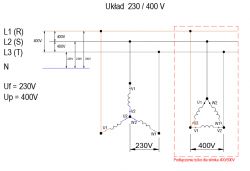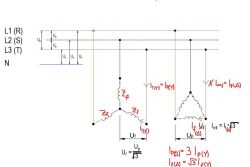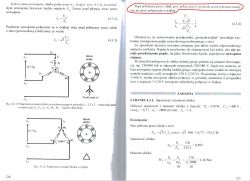Power supply to motors - the problem of star-delta switching
Problem : When can I connect a star-delta switch?
The engine, as an electrical machine capable of converting electrical energy into mechanical energy, requires an appropriate power supply.
The nameplate should describe all the necessary information, but as it turns out, not everything is so clear.
Each motor has in its construction the basic elements that enable it to work - windings.
The winding of the motor (coil), as an element usually made of copper wire, has its operating parameters, and to put it simply, the voltage for which it was built.
For example as below:

You can often find such records on engines:
230 (D) / 400 (Y)
400 (D) / 690 (Y)
For example:

It just means that the proper connection of the motor is required.
The motor that is to work in a typical Polish 230 / 400V network, for such designation 230/400 D / Y, can only work in the star (Y) configuration.
Why?
Because its coils are designed to work with 230V. Working in a delta configuration, it will give the coils a voltage of 400V.
Going back to our motor windings (coils), we mark their ends as follows:

We can use them to connect two systems:

Why then do we have to be careful to what network (or voltage) we connect the above systems?
Answer in the figures below.

Power supply for the standard system ("home" , has two voltages - phase (230V) and phase-to-phase (400V). Therefore, when connecting the 230 (D) / 400 (Y) motor in a triangle (D) configuration, we supply the coil with 400V, where only 230V is allowed. In the star (Y) system, the motor is connected to 400V, but the coils are connected to each other in such a way that only 230V will appear on a single coil.
, has two voltages - phase (230V) and phase-to-phase (400V). Therefore, when connecting the 230 (D) / 400 (Y) motor in a triangle (D) configuration, we supply the coil with 400V, where only 230V is allowed. In the star (Y) system, the motor is connected to 400V, but the coils are connected to each other in such a way that only 230V will appear on a single coil.
Therefore, such an engine can't work with the GWIAZDA-TRÓJKĄT switch in this network.
Such an engine can't also work in a triangle pattern in this network.
It can only work in the connection system: Star.

The situation is similar in this case.
The power supply for the industrial system has two voltages - phase (400V) and phase-to-phase (690V). Therefore, when connecting the 230 (D) / 400 (Y) motor in a triangle (D) configuration, we apply the 690V coil, where only 230V is allowed.
Such a motor cannot work in a 400 / 690V industrial network.
In this system, the correct motor for connection may be the motor 400 (D) / 690 (Y), connected in a star configuration.
So what does star-delta switching involve?
It bindsit is, however, that the motor coil will work first in the star, which means that the voltage will be "given" one root of three lower than the rated voltage. This is done to start the motor "with a lower current" - to reduce the starting current. The delta switching (after starting) already supplies the rated voltage to the motor and allows for full power.
Thus, the motor suitable for operation in a star-delta switch system, for a 230 / 400V network system will be a motor with the following parameters:
400 (D) / 690 (Y)
What is the current and voltage situation?
Oh yes:

As you can see, in the case of star connection, the current and voltage are less by a root of three than the rated values for which the device is built.
This will not cause the engine to overheat or burn the coils, it can only cause the "power shortage" effect and, consequently, the engine will not start.
Problem : When can I connect a star-delta switch?
The engine, as an electrical machine capable of converting electrical energy into mechanical energy, requires an appropriate power supply.
The nameplate should describe all the necessary information, but as it turns out, not everything is so clear.
Each motor has in its construction the basic elements that enable it to work - windings.
The winding of the motor (coil), as an element usually made of copper wire, has its operating parameters, and to put it simply, the voltage for which it was built.
For example as below:

You can often find such records on engines:
230 (D) / 400 (Y)
400 (D) / 690 (Y)
For example:

It just means that the proper connection of the motor is required.
The motor that is to work in a typical Polish 230 / 400V network, for such designation 230/400 D / Y, can only work in the star (Y) configuration.
Why?
Because its coils are designed to work with 230V. Working in a delta configuration, it will give the coils a voltage of 400V.
Going back to our motor windings (coils), we mark their ends as follows:

We can use them to connect two systems:

Why then do we have to be careful to what network (or voltage) we connect the above systems?
Answer in the figures below.

Power supply for the standard system ("home"
Therefore, such an engine can't work with the GWIAZDA-TRÓJKĄT switch in this network.
Such an engine can't also work in a triangle pattern in this network.
It can only work in the connection system: Star.

The situation is similar in this case.
The power supply for the industrial system has two voltages - phase (400V) and phase-to-phase (690V). Therefore, when connecting the 230 (D) / 400 (Y) motor in a triangle (D) configuration, we apply the 690V coil, where only 230V is allowed.
Such a motor cannot work in a 400 / 690V industrial network.
In this system, the correct motor for connection may be the motor 400 (D) / 690 (Y), connected in a star configuration.
So what does star-delta switching involve?
It bindsit is, however, that the motor coil will work first in the star, which means that the voltage will be "given" one root of three lower than the rated voltage. This is done to start the motor "with a lower current" - to reduce the starting current. The delta switching (after starting) already supplies the rated voltage to the motor and allows for full power.
Thus, the motor suitable for operation in a star-delta switch system, for a 230 / 400V network system will be a motor with the following parameters:
400 (D) / 690 (Y)
What is the current and voltage situation?
Oh yes:

As you can see, in the case of star connection, the current and voltage are less by a root of three than the rated values for which the device is built.
This will not cause the engine to overheat or burn the coils, it can only cause the "power shortage" effect and, consequently, the engine will not start.





